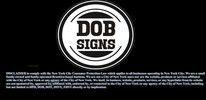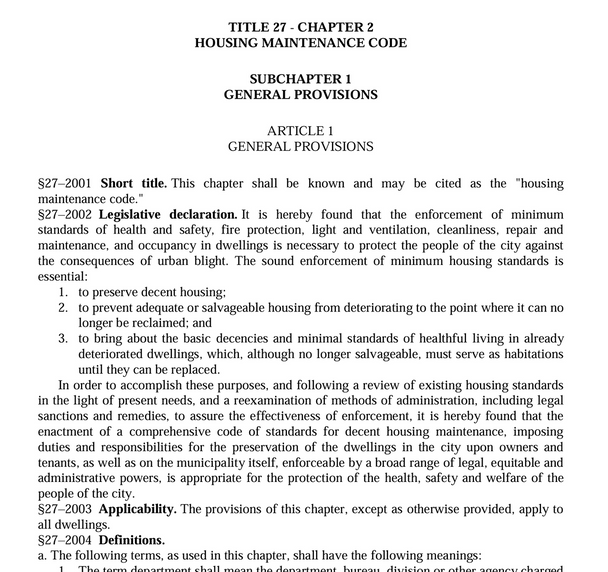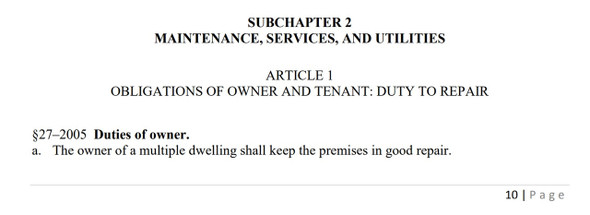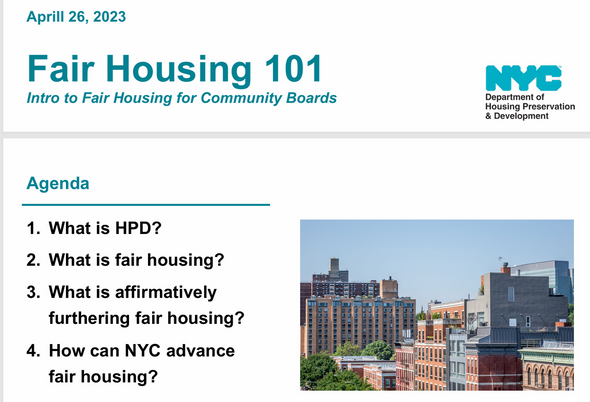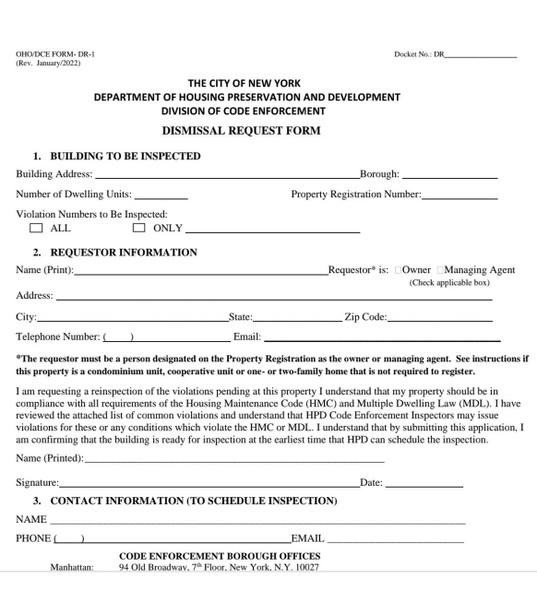Description
Free download of NYC Housing Maintenance Code
New York City Administrative Code is known as the Housing Maintenance Code (HMC). It establishes minimum housing standards for residential buildings to ensure health, safety, habitability, and maintenance in NYC.
Key Purpose of the Housing Maintenance Code
The HMC is designed to: ✔ Protect tenant rights
✔ Ensure proper maintenance of buildings
✔ Prevent unsafe living conditions
✔ Enforce landlord responsibilities
Title 27 - Chapter 2: Housing Maintenance Code
Subchapter 1: General Provisions
- §27–2001: Short title – "Housing Maintenance Code."
- §27–2002: Legislative declaration – Establishes the purpose of the code to protect health, safety, and welfare in residential buildings.
- §27–2003: Applicability – The code applies to all dwellings unless stated otherwise.
- §27–2004: Definitions – Key terms such as "dwelling," "family," "multiple dwelling," "owner," "tenant," etc.
Subchapter 2: Maintenance, Services, and Utilities
Article 1: Obligations of Owners and Tenants
- §27–2005: Duties of owners – Owners must maintain buildings in good repair and comply with all housing codes.
- §27–2006: Duties of tenants – Tenants must prevent damage caused by their own negligence.
- §27–2007: Tenant responsibilities – Tenants cannot remove safety devices, obstruct fire escapes, or damage property.
- §27–2008: Owner’s right of access – Owners can enter apartments for repairs and inspections with reasonable notice.
- §27–2009: Tenant violations as grounds for eviction – Wilful damage or obstruction of maintenance can lead to eviction.
- §27–2009.1: Pets in rental units – If a tenant openly keeps a pet for three months without landlord objection, the pet lease restriction is waived.
- §27–2009.2: Safe Construction Bill of Rights – Tenants must be notified about construction projects affecting services.
Article 2: Cleaning Requirements
- §27–2010: Exterior areas – Owners must maintain roofs, yards, and open spaces in a clean condition.
- §27–2011: Common areas – Public spaces in buildings must be kept clean.
- §27–2012: Apartment cleanliness – Tenants must keep units clean; landlords must clean shared spaces in rooming houses.
Article 3: Painting Requirements
- §27–2013: Interior painting – Owners must repaint apartments every three years or sooner if required.
- §27–2014: Window frames and fire escapes – Must be repainted regularly.
- §27–2015: Courts and shafts – Owners must maintain light-colored paint for these areas.
- §27–2016: Paint quality and repainting frequency – Regulated by the Department of Housing Preservation and Development (HPD).
Article 4: Extermination and Rodent Eradication
- §27–2017: Definitions – Includes pests, mold hazards, and indoor allergen hazards.
- §27–2017.1: Owner responsibility for pest control – Owners must prevent and remediate pest infestations.
- §27–2017.2: Annual pest inspections – Owners must inspect and notify tenants about indoor allergens.
- §27–2017.3: Mold violations – Specifies violation levels based on mold size:
- <10 sq. ft. – Non-hazardous
- 10–30 sq. ft. – Hazardous
- >30 sq. ft. – Immediately hazardous
- §27–2017.4: Pest violations – Cockroach, mouse, and rat infestations are immediately hazardous.
- §27–2017.5: Pest and mold removal before unit turnover – Units must be cleaned and remediated before new tenants move in.
- §27–2017.6: HPD inspections – The department must inspect mold and pest complaints within 30 days.
- §27–2017.7: Implementation and enforcement – Training and enforcement procedures for inspectors.
- §27–2017.8: Integrated Pest Management (IPM) – Landlords must follow specific pest control measures, including sealing cracks and eliminating water sources.
- §27–2017.9: Mold remediation standards – Owners must fix leaks and use containment methods before removing mold.
Other Key Regulations in the Code
Heating, Plumbing, and Water Services
- §27–2028: Heat requirements – During heating season (Oct. 1–May 31), apartments must be at least 68°F during the day and 62°F at night.
- §27–2031: Hot water – Must be provided year-round at a minimum temperature of 120°F.
- §27–2032: Cold water – Must be supplied at all times.
- §27–2037: Toilets and plumbing – Units must have a working toilet, sink, and bathtub or shower.
- §27–2039: Gas and electric service – Owners cannot shut off utilities as a form of eviction.
Lead-Based Paint Regulations
- §27–2056.3: Lead hazard abatement – Owners must remove lead-based paint hazards in apartments occupied by children under 6 years old.
- §27–2056.9: Annual lead inspections – Required for buildings built before 1960.
Safety and Emergency Systems
- §27–2045: Smoke detectors – Must be installed and maintained.
- §27–2046: Carbon monoxide detectors – Required in all dwelling units.
- §27–2047: Natural gas alarms – Required in some buildings under Local Law 157 (effective May 1, 2025).
- §27–2048: Fire escape maintenance – Must be structurally sound and unobstructed.
Tenant Harassment and Protections
- §27–2005(d): Harassment is prohibited – Landlords cannot pressure tenants to vacate illegally.
- §27–2115: Penalties for violations – Owners who fail to correct hazardous violations face civil fines.
Conclusion
The Housing Maintenance Code outlines the legal responsibilities of landlords and tenants in New York City, covering: ✔️ Building maintenance
✔️ Tenant protections
✔️ Pest control and mold remediation
✔️ Heat, plumbing, and water supply
✔️ Lead-based paint removal
✔️ Smoke and gas detector requirements
If you need more details on a specific section, let me know!
DISCLAIMER DISCLAIMER ON LEGAL CODES DISCLAIMER ON SIGN USE GENERAL INFORMATION DISCLAIMER
We are a small, family-owned and family-operated Brooklyn-based business. We are not a City of New York store, nor are our website, products, or services affiliated with the City of New York or any agency of the City of New York. Neither we, nor our business, websites, products, services, or any hyperlinks from our website are sponsored by, approved by, affiliated with, endorsed by, or connected to the City of New York or any agency of the City of New York, including but not limited to HPD, DOB, DOT, DSNY, FDNY, or any federal entity, directly or by implication.
The codes, regulations, and requirements referenced on our website may not represent the most recent or updated versions. State, federal, or local regulatory agencies may have more current or accurate information. We make no warranties or guarantees about the accuracy, completeness, or adequacy of the information provided on this site or linked from it. Customers should verify all information by reviewing the official sources directly.
The requirements for sign content depend on intended use and applicable laws. The buyer is solely responsible for determining the appropriate content for a sign or package of signs. We make no warranty or representation regarding the suitability of any sign for a specific application. It is the customer’s responsibility to ensure that the signs ordered are in compliance with all applicable state, federal, local, and municipal laws. Customers are encouraged to carefully review our Terms and Conditions prior to purchase.
All content on this site is provided for informational purposes only and does not constitute legal advice, professional advice, or a definitive statement of law. For guidance on specific requirements, customers should consult the laws and regulations referenced, as well as any rules applicable in their jurisdiction. You may wish to consult with an attorney or qualified professional to ensure compliance with all applicable legal obligations.
